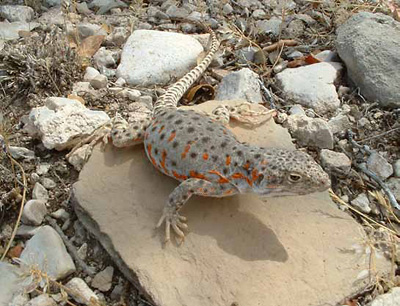Guadalupe Mountains National Park (NP) is located in southwestern Texas in the Chihuahuan Desert and boasts a large range of habitats, plants, and animals. The park includes the highest point in Texas (8,749 ft), reliable springs, sand dunes, and forests.

James Borgmeyer
This inventory focused primarily on McKittrick Canyon, a very diverse riparian area, and the Salt Basin Dunes area, characterized by creosote flats, gypsum and quartz dunes. A previous survey of McKittrick Canyon found a large number of reptiles and amphibians, so there was a heavy focus on this area to maximize the detection of reptile and amphibian species. The Salt Basin Dunes area was surveyed to find new species characteristic of habitat found only in this section of the park and to document species composition and distribution in this area which had not been previously surveyed.
The inventory took place from May to August 2003 and June to August 2004—153 person-days in total. In 2003, the precipitation was not heavy enough or long enough to induce seasonal amphibian calls and aggregation at seasonal ponds. The 2004 survey season was much wetter, but did not seem to influence the activities of reptiles and amphibians in the park. Most park staff reported seeing fewer snakes in 2004 than in previous years, and the researchers only heard one species of amphibian calling in the park.
Methods
Several search approaches were implemented to find reptiles and amphibians: foot surveys, incidental observations, pitfall traps, and road cruising. Different approaches were used each year (2003 and 2004) to maximize the likelihood of finding different species. For each reptile or amphibian observed, location, time, weather, and species were recorded.
Foot surveys were conducted at times when reptiles and amphibians were most likely to be active (morning around sunrise and evening around sunset). Most of the foot surveys were conducted off-trail. While on foot, searches included looking under rocks and logs, and mirrors and flashlights were used to illuminate crevices. Incidental observations were recorded while the researchers were not conducting formal searches (e.g., on days off or while driving to a search area).
Pitfall traps were used to capture small reptiles and amphibians running or crawling across the ground. In 2003, two sets of pitfall traps were checked by park staff and volunteers daily (125 times). The traps in Guadalupe Mountains NP were dismantled after completion of surveys. Road cruising surveys were conducted at night to find amphibians and nocturnal snakes and lizards.
Voucher specimens were collected for nearly each species found in the park. Voucher specimens provide proof that the species actually occurred in the park during the inventory and help to confirm it was correctly identified in the field. These specimens provide important data about reproduction, diet, health, and morphology. DNA collected from voucher specimens can be used to examine population questions and genetic relationships within and between species. For this inventory, the voucher specimens are on permanent loan to and stored at the Museum of Southwestern Biology, University of New Mexico, Albuquerque, and are freely available to researchers and managers.
Results
In total, 1,931 reptiles and amphibians were found at Guadalupe Mountains NP during this inventory, representing 48 species: seven frogs and toads, 18 lizards, 21 snakes, and two turtles. The majority of observations were recorded during foot surveys: 1,580 animals of 46 species. Incidental observations accounted for 249 animals of 26 species. Pitfall traps caught 64 animals of 11 species and in 16 road cruising surveys, 38 animals of six species were observed. A total of 51 voucher specimens comprising 46 species were collected.
Two species found in Guadalupe Mountains NP were listed as state endangered by Texas, the Texas horned lizard (Phrynosoma cornutum) and Hernandez’s short-horned lizard (Phrynosoma hernandesi hernandesi). No non-native reptile or amphibian species were found during this inventory.
Discussion
In order to determine what percentage of the actual total herpetofauna was documented in this inventory, the results were compared to lists of species likely to occur in the park based on previous lists and sighting information. It is estimated that there are seven species that are likely to occur that were not observed (one toad, one salamander, one lizard, and four snakes), meaning this inventory may have documented 87% of the reptile and amphibian species present. Nine species found were not previously documented in the park. Eight of these species would be expected based on the habitat available. One of the species found in the Salt Basin Dunes area, the Trans-Pecos threadsnake (Leptotyphlops humilis segregus), appears to have significantly extended its range. The individual found in this inventory appeared to be the only voucher record of this species within at least 50 miles.
This inventory can be used as baseline data for future monitoring. Long-term monitoring and/or repeated inventories may help detect changes within reptile and amphibian communities caused by climate change, drought, invasion by non-native species, wildland fire, or other factors. Reptile and amphibian populations can change dramatically between surveys in a given year due to the timing and amounts of precipitation. Future monitoring or inventories should survey each area multiple times in a season.
See Chapter 7 (Literature Cited and Project Contacts) for a link to the full report including a list of species found during this inventory.
Part of a series of articles titled Chihuahuan Desert Network Reptile and Amphibian Inventories.
Last updated: August 17, 2017
